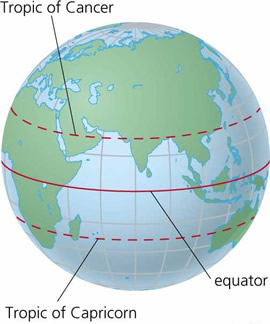Difference between Equator and Poles
Key Difference: The equator is the point from which the latitude is calculated. In other words, it is the 0° latitude line. A pole consists of two points: North Pole and South Pole. The North Pole lies 90° on the north of the equator and the South Pole lies 90° on the south of the equator, respectively.
 The equator is the point from where the latitude is calculated. In other words, it is the 0° latitude line. It is the imaginary circle that draws a line between the Northern hemisphere and Southern hemisphere. The term equator is derived from the Latin phrase, 'circulus aequator diei et noctis', meaning ‘circle equalizing day and night’. It is one of the main imaginary circles on latitude, which actually is based on the relationship between the Earth’s axis of rotation. In simple terms, equator is the imaginary circle, which cuts the spherical Earth exactly in the middle, i.e. in two halves. The Earth's axis along the equator at one revolution per sidereal day is 0.0339 m/s².
The equator is the point from where the latitude is calculated. In other words, it is the 0° latitude line. It is the imaginary circle that draws a line between the Northern hemisphere and Southern hemisphere. The term equator is derived from the Latin phrase, 'circulus aequator diei et noctis', meaning ‘circle equalizing day and night’. It is one of the main imaginary circles on latitude, which actually is based on the relationship between the Earth’s axis of rotation. In simple terms, equator is the imaginary circle, which cuts the spherical Earth exactly in the middle, i.e. in two halves. The Earth's axis along the equator at one revolution per sidereal day is 0.0339 m/s².
The line is drawn between the continents of South America and Africa, and crosses the number of islands, and runs through 14 countries.
 A pole consists of two points: North Pole and South Pole. It is the main point where the axis of rotation gets together to the surface of the planet. Lines of longitude all run from pole to pole, and they are all roughly the same length but not parallel, as they converge towards the poles. The North Pole lies 90° on the north of the equator and the South Pole lies 90° on the south of the equator.
A pole consists of two points: North Pole and South Pole. It is the main point where the axis of rotation gets together to the surface of the planet. Lines of longitude all run from pole to pole, and they are all roughly the same length but not parallel, as they converge towards the poles. The North Pole lies 90° on the north of the equator and the South Pole lies 90° on the south of the equator.
The direction of the Earth’s poles, relative to the Sun, causes the difference in energy received at the Equator and the poles. The normal amount of solar radiation reduces from the Equator to the poles. This is because the low latitudes (near the Equator deliver relatively large amounts of radiation all year, and at high latitudes (near the poles), the more slanting angle of the Sun’s rays together with long periods of darkness in the winter, result in a low amount of received radiation.
Comparison between Equator and Poles:
|
|
Equator |
Poles |
|
Description |
The equator is the imaginary circle, which cuts the spherical Earth exactly in the middle, i.e. in two halves. |
A pole consists of two points: North Pole and South Pole. The North Pole lies 90° on the north of the equator and the South Pole lies 90° on the south of the equator. |
|
Temperature |
Hot |
Cold |
|
Gravitational acceleration |
9.78 m/s2 at the equator |
9.83 m/s2 at the poles |
|
Effects |
There is little diffusion of sunlight, thus most of the countries experience summer throughout the year. |
When sunlight does reach the poles, it is diffused, or broken up, by the planet’s atmosphere, thus this reduces the heating effect of the sunlight. |
Image Courtesy: images.yourdictionary.com, adventure.howstuffworks.com









Comments
Anonymous
Tue, 12/12/2017 - 00:33
Hassan
Mon, 11/13/2017 - 12:38
Aisha
Sun, 05/15/2016 - 23:39
Add new comment